|
Title
I provides emergency assistance to eligible metropolitan areas
(EMAs) that are most severely affected by the HIV/AIDS epidemic.
These funds may be used to provide a range of community-based
services for persons living with HIV (PLWH).
In 2003,
51 Ryan White CARE Act Title I EMAs (otherwise referred to as
grantees) contracted with 1,520 agencies / organizations (otherwise
referred to as providers) to provide CARE Act eligible services
to HIV-positive individuals. They served a total of 840,421
clients of which 662,662 were HIV-positive duplicated clients
and 177,759 were affected [1] duplicated clients.
Table
of Contents:
- Types
of Title I Provider Organizations / Agencies Serving Clients
- Ownership
Status of Title I Organizations/Agencies Serving Clients
- Number
of Duplicated Clients Served by Title I Providers
- HIV/AIDS
Status of Duplicated Clients Served by Title I Providers
- Gender
of Duplicated Clients Served by Title I Providers
- Age
of Duplicated Clients Served by Title I Providers
- Ethnicity
of Duplicated Clients Served by Title I Providers
- Race
of Duplicated Clients Served by Title I Providers
- Health
Insurance Status of Duplicated Clients Served by Title I
Providers
- Number
of Visits for Health Care and Case Management Services to
Title I Providers
- Number
of Visits per Client to Title I Service Providers
- Number
of Duplicated Clients Receiving Support Services from Title
I Providers
- Percentage
Distribution of HIV Positive Clients by Gender Receiving
Medical Care from Title I Providers
- Percentage
Distribution of HIV Exposure among Duplicated HIV Positive
Clients from Title I Providers
- Data
Considerations
Types
of Title I Provider Organizations / Agencies Serving Clients
N=1,520
providers

- Source:
2003 CARE Act Data Report, Section 1, Item 7
- Percentages
may not sum to 100 percent due to rounding error
- Other*
includes solo/group private medical practice, agency reporting
for multiple fee-for-service providers, PLWHA coalition,
and VA facility
TABLE
OF CONTENTS
Ownership
Status of Title I Organizations / Agencies Serving Clients
N=1,520
providers

- Source:
2003 CARE Act Data Report, Section 1, Item 9
- Percentages
may not sum to 100 percent due to rounding error
TABLE
OF CONTENTS
Number
of Duplicated Clients Served by Title I Providers

- Source:
2003 CARE Act Data Report, Section 2, Items 24 & 25
TABLE
OF CONTENTS
HIV/AIDS
Status of Duplicated Clients Served by Title I Providers
N=840,421
duplicated clients
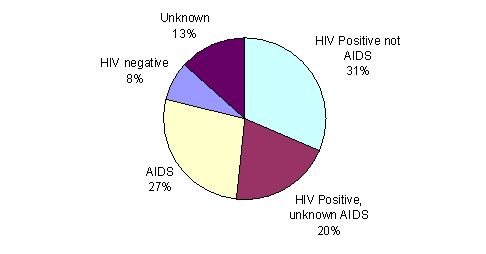
- Source:
2003 CARE Act Data Report, Section 2, Items 33
- Percentages
may not sum to 100 percent due to rounding error
TABLE
OF CONTENTS
Gender
of Duplicated Clients Served by Title I Providers
N=840,421
duplicated clients
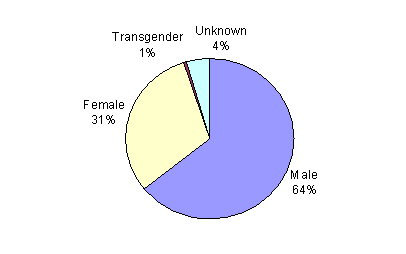
- Source:
2003 CARE Act Data Report, Section 2, Item 26
- Percentages
may not sum to 100 percent due to rounding error
TABLE
OF CONTENTS
Age
of Duplicated Clients Served by Title I Providers
N=840,421
duplicated clients
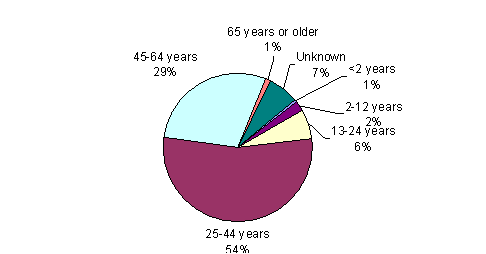
- Source:
2003 CARE Act Data Report, Section 2, Item 27
TABLE
OF CONTENTS
Ethnicity
of Duplicated Clients Served by Title I Providers
N=840,421
duplicated clients
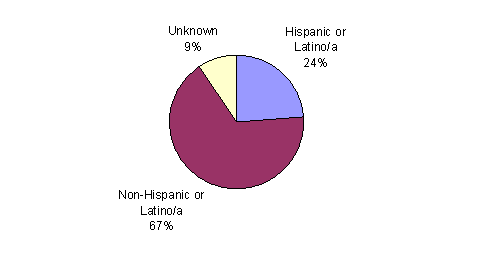
- Source:
2003 CARE Act Data Report, Section 2, Items 28
TABLE
OF CONTENTS
Race
of Duplicated Clients Served by Title I Providers
N=840,421
duplicated clients
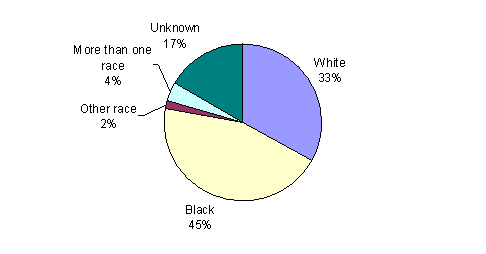
- Source:
2003 CARE Act Data Report, Section 2, Items 29
- Percentages
may not sum to 100 percent due to rounding error
- “Other
race” category includes Asian, Native American or Other
Pacific Islander, and American Indian or Alaska Native.
TABLE
OF CONTENTS
Health
Insurance Status of Duplicated Clients Served by Title I Providers
N=840,421
duplicated clients
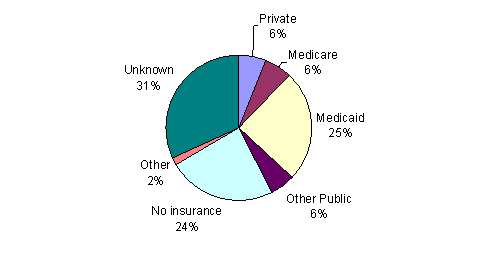
- Source:
2003 CARE Act Data Report, Section 2, Items 32
- Providers
report the medical insurance that provides the most reimbursement
if a client has more than one source of medical insurance.
- Examples
of Other Public medical insurance include State-funded insurance
plans, military health care (CHAMPUS), State Children’s
Health Insurance Program (SCHIP), Indian Health Services,
and Veterans Health Administration.
- Percentages
may not sum to 100 percent due to rounding error
TABLE
OF CONTENTS
Number
of Visits for Health Care and Case Management Services to
Title I Providers

- Source:
2003 CARE Act Data Report, Section 3, Items 35
- Home
health* includes para-professional care, professional care,
and specialized care
TABLE
OF CONTENTS
Number
of Visits per Client to Title I Service Providers
|
Service |
Number of Service Provider |
Percent of service providers (N=1,520) |
Average number of visits per client per provider * |
Median number of visits per client * |
Range number of visits per client * |
|
Ambulatory/outpt. medical care |
482
|
32%
|
7.90
|
5.78
|
1-134.00
|
|
Mental
health services
|
537
|
35%
|
9.31
|
6.14
|
1-282.75
|
|
Oral
health care
|
227 |
15% |
23.78 |
8.05 |
1-336.21 |
|
Substance
abuse services–outpatient
|
337
|
22%
|
65.30
|
28.35
|
1-365.00
|
|
Substance
abuse services–residential
|
70
|
5%
|
31.39
|
7.63
|
1-365.00
|
Rehabilitation
services
|
31 |
2% |
9.27 |
4.41 |
1-43.57 |
Home
health: para-professional care
|
74 |
2% |
2.92 |
2.83 |
1-12.45 |
Home
health: professional care
|
64 |
4% |
32.99 |
20.50 |
1-111.25 |
| Home
health: specialized care |
26 |
2% |
13.42 |
4.25 |
1-119.23 |
Case
management services
(among HIV + clients)
|
776 |
51% |
15.22 |
9.77 |
1-240.00 |
- Source:
2003 CARE Act Data Report, Section 3, Items 35
- (*)
Data reported in this table are based on valid reports only.
Valid data are defined as providers reporting complete data
for both the number of clients served and number of visits.
- For
each service type, the actual number of providers serving
clients is higher. However, the average number of visits
per client was calculated only for those providers with
valid data for number of clients served and number of client
visits. Providers may offer multiple services; thus, a provider
may be included in more than one service category.
- A
client may only have one visit for each service per day.
For residential substance abuse treatment, each day in a
residence facility equals one visit.
TABLE
OF CONTENTS
Number
of Duplicated Clients Receiving Support Services from Title
I Providers

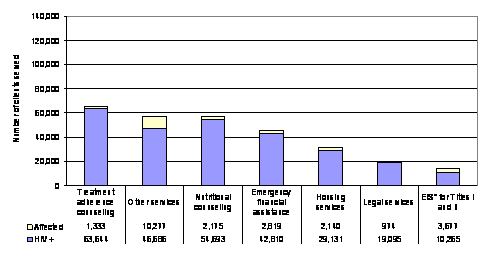
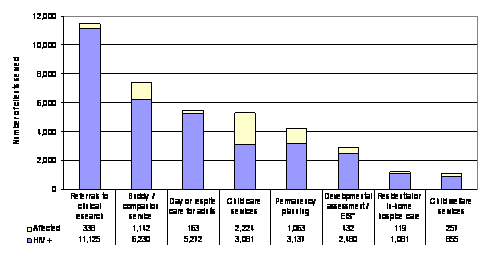
- Source:
2003 CARE Act Data Report, Section 3, Items 35
- Clients
served include all individuals who had at least one visit
for any eligible service during the reporting period.
- (*)
Early Intervention Services
TABLE
OF CONTENTS
Percentage
Distribution of HIV Positive Clients by Gender Receiving Medical
Care from Title I Providers
N=253,542
duplicated clients
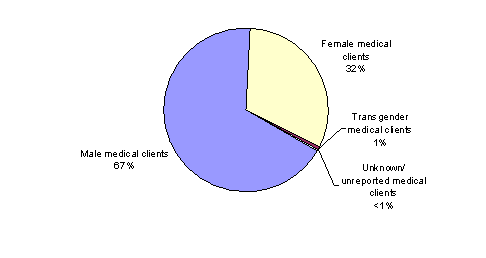
- Source:
2003 CARE Act Data Report, Section 5, Items 45
- These
data are limited to medical service providers as reported
in section 3, item 1a under ambulatory/outpatient medical
care provider. Clients reported in section 5 may have received
care other than medical and therefore the number of clients
reported in section 5 may not agree with the number of clients
reported in section 3 under ambulatory/outpatient medical
care.
- Percentages
may not sum to 100 percent due to rounding error
TABLE
OF CONTENTS
Percentage
Distribution of HIV Exposure among Duplicated HIV Positive
Clients from Title I Providers
N=239,904
duplicated clients

- Source:
2003 CARE Act Data Report, Section 5, Items 46
- These
data are limited to medical service providers as reported
in section 3, item 1a under ambulatory/outpatient medical
care provider. Clients reported in section 5 may have received
care other than medical and therefore the number of clients
reported in section 5 may not agree with the number of clients
reported in section 3 under ambulatory/outpatient medical
care.
- HIV
exposure information was not reported for 13,638 HIV positive
duplicated medical clients
- Percentages
may not sum to 100 percent due to rounding error
TABLE
OF CONTENTS
Data
Considerations
Data
in this presentation were submitted by Title I providers,
many of whom also receive funds from other sources, including
other CARE Act Titles (i.e., Title II, Title III, Title IV,
and/or Title IV-Youth). Since many providers do receive funds
from multiple CARE Act Titles, it is often impossible for
them to distinguish which funds paid for various services
they provide. Therefore, the data in these slides do not necessarily
reflect services rendered or clients served exclusively with
Title I funds. Rather, it is a presentation of provider, client,
and service characteristics for providers who received Title
I funds.
These
data can not be compared with Title I, II, III, IV, or Title
IV-Youth data collected prior to 2002. In previous years,
HRSA/HAB used separate, Title-specific data systems to collect
client and service information from CARE Act grantees and
providers. Providers were required to complete separate data
reporting forms for each Title-funding they received. Under
the new CADR reporting system implemented in 2002, all providers,
even those who are multiply-funded, complete one CADR, and
report on all clients served regardless of funding source.
Ryan
White CARE Act providers have the option of reporting on eligible
or funded services[2]. When they report on
eligible services, providers are reporting on any service
permitted under any Title of the CARE Act, regardless of whether
or not the providers use a specific Title to pay for these
services. Conversely, if providers report on funded services,
the data they report only includes those services that were
actually paid for using CARE Act funds. Reporting eligible
services provides a comprehensive picture of the services
being delivered to HIV-positive clients.
Title I grantees have numerous providers under subcontract
and each of these providers completes the same CADR. While
data are unduplicated at the provider level, any summary of
the total number of clients served and their demographic characteristics
at the grantee or national level may result in duplicated
client counts.
Since
these data are aggregated at the national or grantee level,
clients that may have been new to one provider could be continuing
services to another service provider.
Clients
served include all individuals who had at least one visit for
any eligible service provided by a Title I provider during the
reporting period, regardless of additional funding source.
An affected
client is a family member or partner of an infected client
who received case management or other supportive services
during the calendar year. Affected clients include those who
are HIV negative as well as those with unknown HIV status.
Affected clients include those receiving Title I and II Early
Intervention Services. Affected family members of HIV positive
patients are served under Title IV.
“New”
clients include clients whose first receipt of services from
the provider agency occurred during the reporting period.
TABLE
OF CONTENTS
[1]
An affected client is a family member or partner of an infected
client who received case management or other supportive services
during the calendar year.
[2]
All grantees and providers must report on eligible services
unless they have prior permission from their HRSA project
officer to report only funded services.
TABLE
OF CONTENTS
|






![]()